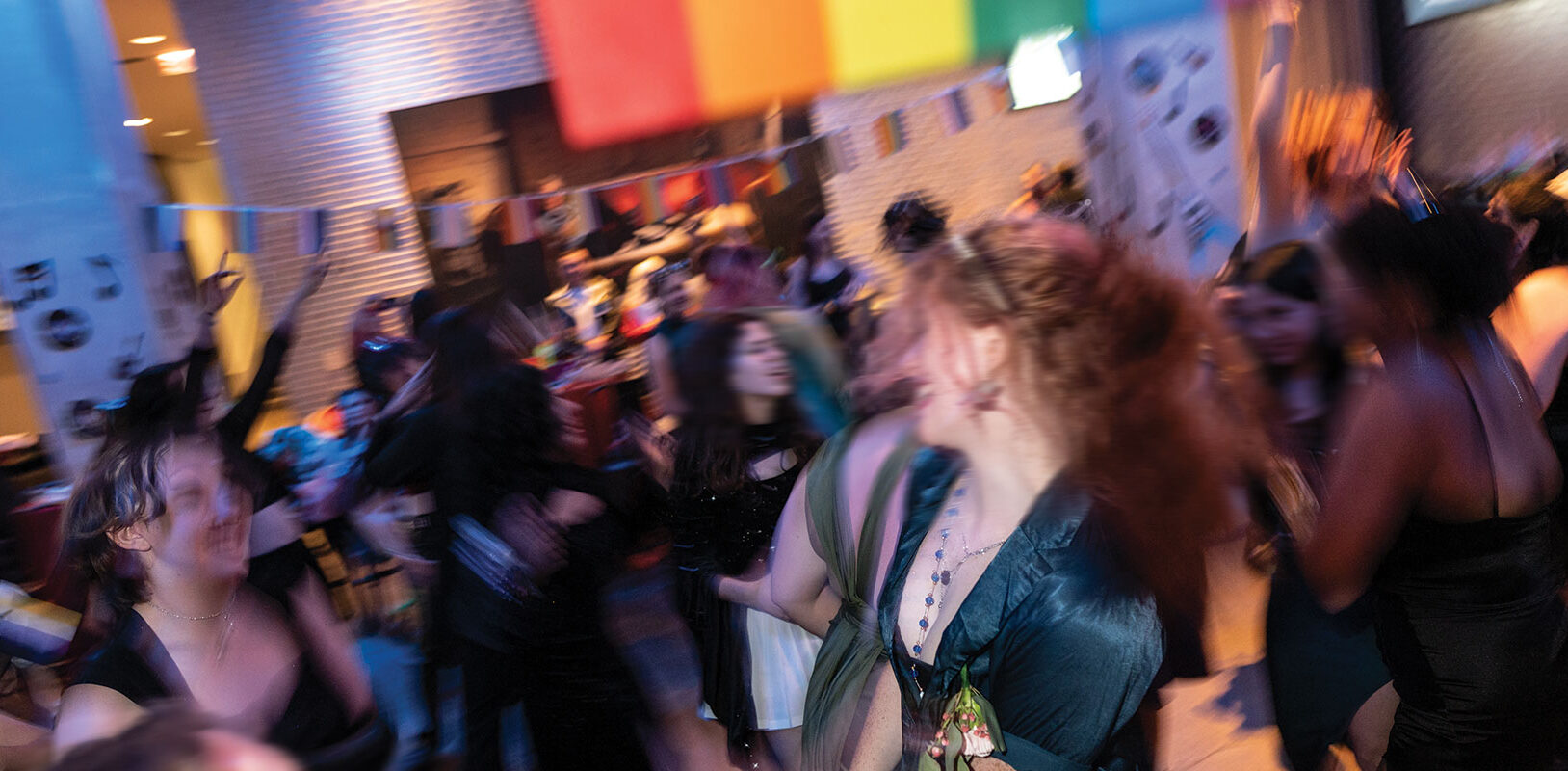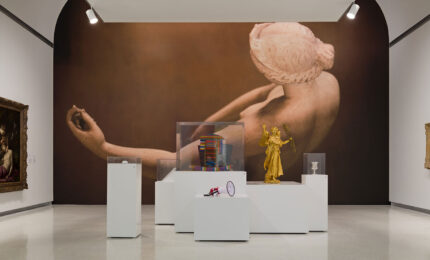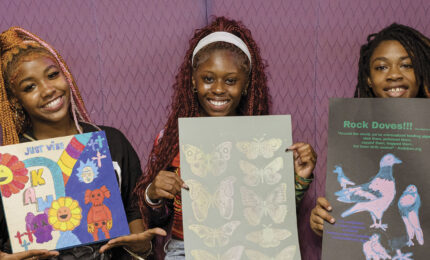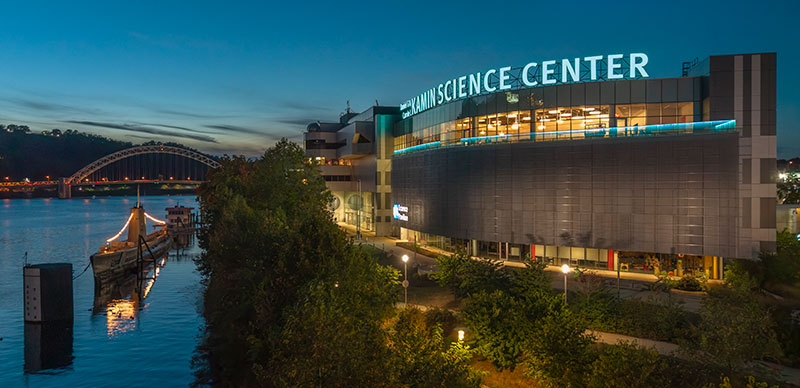Editor’s Note: The names of all minors interviewed for this article have been changed to protect their privacy.
It’s a humid Saturday night in June, and teenagers are posing for selfies on the entrance steps of The Andy Warhol Museum. They are decked out in their finest formal wear—sidewalk-sweeping gowns, vintage polyester suits a touch too tight in the shoulders, and platform heels that somebody will surely kick off in an hour. The chattering thrum is punctuated with exclamations of, “You look amazing!” and requests for one more shot.
It’s prom season in America, and this scene is playing out in backyards and hotel ballrooms across the country. But what awaits these young adults inside The Warhol is more than slow dances and boutonnieres—tonight, the museum is their momentary place of refuge and relief.
Since 2014, The Warhol has hosted the LGBTQ+ Youth Prom, one of the only proms catering to queer young people in southwestern Pennsylvania. The event, open to people ages 13 to 20, is a safe, gender-inclusive celebration at a time when many state and national politicians and local school boards are rolling back the social and legal advances achieved by LGBTQ+ people in the last two decades.
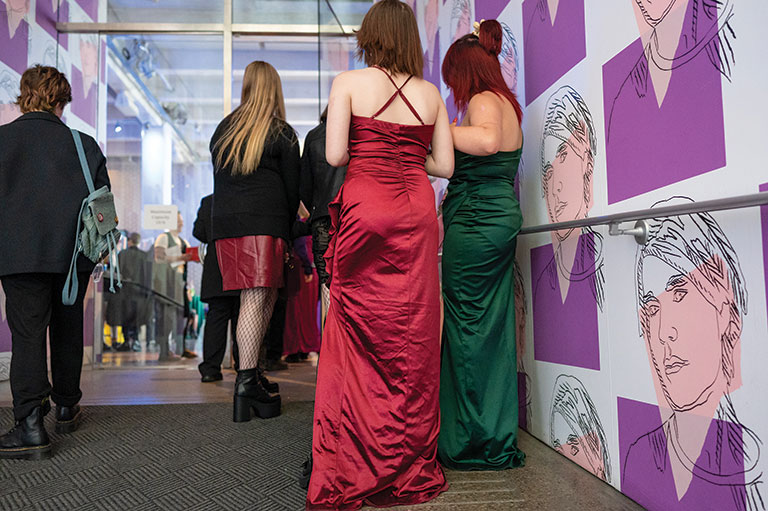
“For some local queer youth who experience bullying, harassment, and even unsupportive faculty and administrators, going to their official high school prom isn’t an option,” says Mona Wiley, inclusion programs coordinator at The Warhol and a lead organizer of the prom. “The Warhol’s LGBTQ+ Youth Prom is a unique event that creates lasting memories, a sense of belonging, and the ability to participate in a significant coming-of-age milestone for attendees, regardless of their gender identity or sexual orientation.”
Seeking belonging
Into the sea of sequins and sparkle on The Warhol’s dance floor enters Kai, a 16-year-old vision—shoulder-grazing turquoise locs, a sleeveless black mini dress, fishnet thigh-highs, chunky heels, and blue-tinted eyeglasses, the lenses shaped like clouds. They spot their partner, Mochi, and he presents them with a corsage of orange and yellow roses. When Mochi slides it on their wrist, they are so happy they are close to sobbing.
The Warhol LGBTQ+ prom is special, Kai says, because it’s a space where they can just be. After surviving a few hellish years of bullying and harassment in their small, rural high school east of Pittsburgh, the rising junior needs a respite.
“The Warhol prom means that I can be in a place where I am accepted; I get to feel safe in my community,” Kai says. “No one is judging me.”
School was not a place that Kai felt safe. One student, in particular, targeted them after they came out as a lesbian by throwing sharp objects and ramming school desks into their legs. They were called “dog” by classmates in the hallway; some even threw food at Kai when they walked through the hallways. One heartbreaking afternoon, students on a school bus woofed and hollered at them as they walked on board.
The Warhol prom means that I can be in a place where I am accepted; I get to feel safe in my community. No one is judging me.
Kai, prom attendee
The stress was debilitating, Kai says, and they sought mental health treatment. Next year, hoping to put distance between them and their harassers, Kai plans to attend high school at Pennsylvania Cyber Charter School, an online public school. While LGBTQ+ youth like Kai are not predisposed to mental illness, they experience mental health issues at much higher rates than their cisgender, straight peers, including elevated risks for suicidal ideation, suicide attempts, depression, and anxiety, according to the Centers for Disease Control and Prevention.
Losing the right to be
An LGBTQ+ prom is a cultural Rorschach test of sorts—for some, it’s an example of progress, of the world becoming kinder to young people who exist outside the mainstream, but to others, the very existence of queer youth is a problem.
Since the start of 2023, more than 500 anti-LGBTQ+ bills have been introduced in state legislatures, including laws specifically targeting the rights of parents to provide gender-affirming care to their children and allowing schools to misgender transgender students and censor curriculums.
Though the politicians behind the bills stated they were protecting children, the proposed laws limit the care and support that can help LGBTQ+ young people flourish.
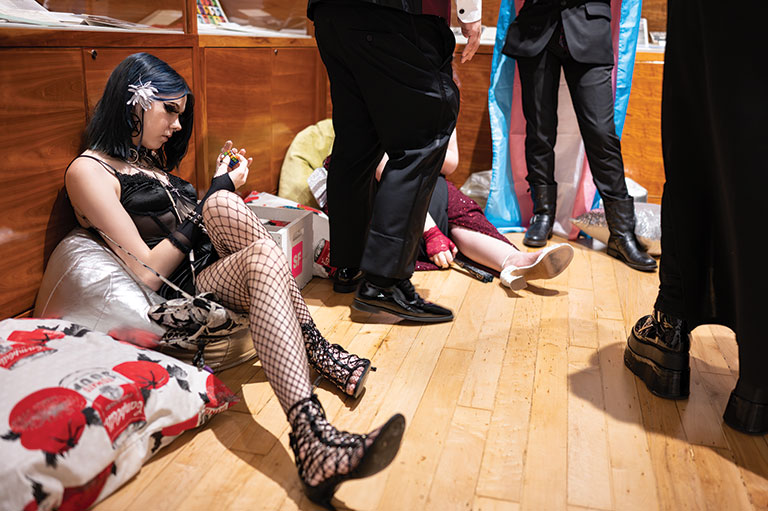
For Kai’s parents, Jody and Randy, it’s hard to reconcile some politicians’ insistence that they know what’s right for young people. They’ve witnessed the real-life consequences when their child has been singled out for being trans.
“We brought Kai to The Warhol prom because we want them to have experiences that don’t feel exclusionary. We want them to celebrate who they are,” says their mother, Jody.
For Kai’s father, the onslaught of anti-LGBTQ+ legislation is antithetical to his upbringing.
“I just feel like, in America, our kids grow up hearing that they can be whatever they want, but now there’s a big asterisk saying, ‘You can be whatever you want, but don’t be gay,’ ” he says. “It’s stupid.”
A dandy Andy, indeed
The leadership and staff of all four Carnegie Museums are committed to cultivating and maintaining a welcoming environment. But The Warhol hosting an LGBTQ+ Youth Prom is especially fitting in light of Andy Warhol’s status as a queer icon, one of the most famous openly gay men of the 20th century.
“Warhol’s Silver Factory art studio served as a gathering place for New York City’s LGBTQ+ community—a safe space where anyone was free to explore their sexuality and gender expression,” says Grace Marston, an arts educator who designed the curriculum of the museum’s monthly Dandy Andy tours that spotlight Andy Warhol’s romantic relationships and queer identity in the context of the gay rights movement.
“Through his paintings, films, television shows, and Interview magazine, he provided platforms for queer creatives to express themselves,” she explains. “Warhol influenced many LGBTQ+ artists during his lifetime, and he continues to inspire today.”
The Warhol’s LGBTQ+ Youth Prom is a unique event that creates lasting memories, a sense of belonging, and the ability to participate in a significant coming-of-age milestone for attendees, regardless of their gender identity or sexual orientation.
Mona Wiley, inclusion programs coordinator at The Warhol
The museum embraces and celebrates Warhol’s vanguard status through its regular programming and acquisitions. In addition to offering the monthly Dandy Andy tours and frequently presenting live, LGBTQ+-identified musical acts, the museum recently installed Anatomy of the Human by queer Nigerian American artist Mikael Owunna. The mural, funded by Citizens, is located across from the museum in Pop Park on East General Robinson Street, part of the museum’s newly launched multi-block Pop District.
Those queer-positive ethics are displayed at the LGBTQ+ Youth Prom. From the pride-flag garlands draped from the pillars surrounding the dance floor to the designated sensory-friendly room, the event is designed to create a space accessible to people of all identities and abilities.
The soundtrack of this year’s prom— the best singalong pop hits of the past few decades—is deftly spun by graduates of the museum’s Teen DJ Academy. The program, presented in partnership with Tech 25, is a five-week immersion taught by professional DJs, culminating in the chance to spin a live set at the LGBTQ+ Youth Prom. Some DJs are as young as 14; tonight is their first prom experience.
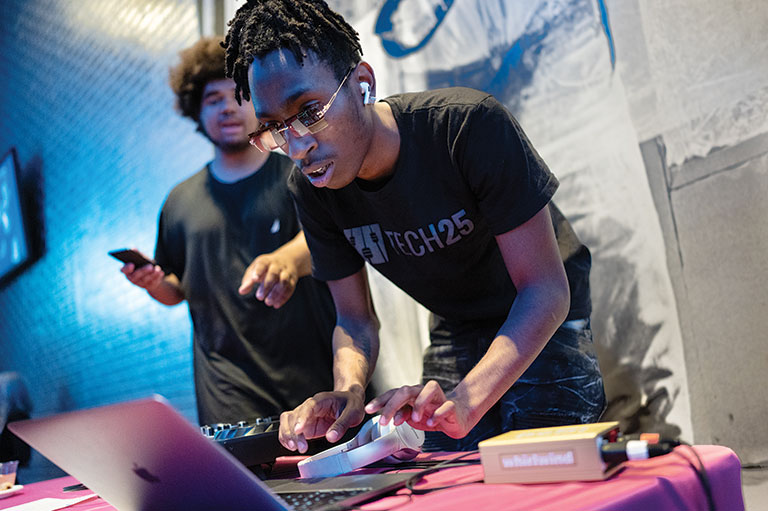
During the event’s first hour, there’s more loitering than dancing—a few brave souls timidly step toward the center of the dance floor and then retreat to the periphery after a song or two. Finally, the raucous really kicks off with the help of the B-52’s Love Shack, and the grooving bodies reach critical mass.
Although the night is by and for the promgoers, it’s meaningful for the adult volunteers in attendance as well. This is the second year that graphic artist and local business owner Jason LeViere has pitched in. While he can’t redo his junior and senior years of high school, he says witnessing these young adults’ joy and seeing them have a different experience than he did growing up is good for his heart.
“I love seeing that everyone is part of one big group just cheering each other on the dance floor. There were all these different cliques when I was in school, but it’s not like that here,” says LeViere, who is gay. “I sometimes didn’t attend dances because I couldn’t bring a guy. I actually ended up planning my prom. If I couldn’t really enjoy myself, I’d put my energy elsewhere.”
Here for a good time
Everything about The Warhol’s prom—from this year’s title, “Andy’s Exploding Plastic Prom,” to the food and activities—is guided by a youth committee that meets over a period of five months. This year’s rock ’n‘ roll theme was manifested in the decorate-your-own sunglasses, CDs, and vinyl records artmaking activities, and also the floral centerpieces in mini snare-drum pots dotting the reception tables.
The 2023 prom is the second one held by the museum since the COVID-19 pandemic lockdown, and though the attendance numbers aren’t quite back to pre-pandemic levels, almost 200 youth representing 21 different schools attended this year’s prom. They hail from the Pittsburgh region and its surrounding counties: Ambridge, Beaver, Lawrence, and Butler; and while this year’s attendees represent a diverse range of genders and geographies, what’s striking is how they revel in sharing community and recognizing the value of each person.
Georgia says she came to prom because her girlfriend was DJing, and The Warhol provided a “safer space” than her school dance. “I have more freedom as a queer person here. I can express myself however I like and choose whoever I want to be with. I don’t have to limit myself just because that’s what I was taught.”
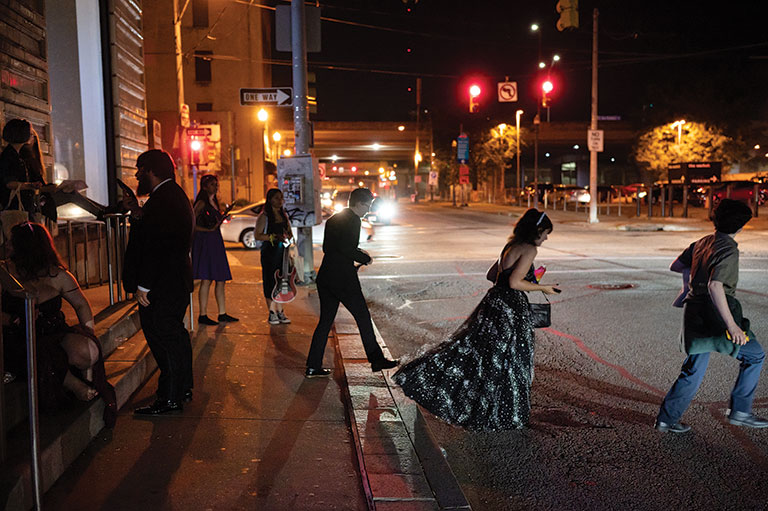
Getting over a bad breakup, Sadie’s friends convinced her to go to prom—it was time for her to finally have some fun. “Kids need safe places to express themselves,” Sadie says. “We can’t be forced into boxes. As a young bi-girl growing up in the church, I always had to fit specific roles. I had to be this perfect girl, and that’s not me. The Warhol is part of the wider community of people who are active in trying to forward human rights.”
Even though he served as the vice president of his school’s student gay-straight alliance, Niko Stripay still sought out connections at the LGBTQ+ Youth Prom. “Events like this one bring us together,” he says, adding, “It can hurt to feel like an outcast, and many of us do feel that way. Here we can belong with each other. It feels good.”
Connection and community
Kai offers more grace to the high schoolers who hurt them than most people could probably muster.
“I’m not entirely sure if politicians influenced the people who bullied me or if that’s just how they were raised,” Kai says. “I consider that those students had something in their life that affected them that made them act like that.”
Though Kai has struggled since coming out, they’ve always had the love and affirmation of their parents. And they’ve found their people—a community whose encouragement and acceptance provide the scaffolding to build a good life.
“The best part of being queer is the supportive friends you make along the way,” Kai says.
This is why The Warhol’s LGBTQ+ Youth Prom is essential programming for the museum—it creates a rare space for connection.
“Young people need a place where they can celebrate their true selves,” Wiley says. “That’s why the prom will continue.”
The night’s pinnacle for Kai was dancing the Electric Slide—a throwback they learned from their parents.
The pleasure of line dancing is the choreography—the unity in rhythm as the group moves in sync with the music. There’s a feeling of affinity. The same feeling you get when you’re in a roomful of people who may not know you but accept you for exactly who you are.
